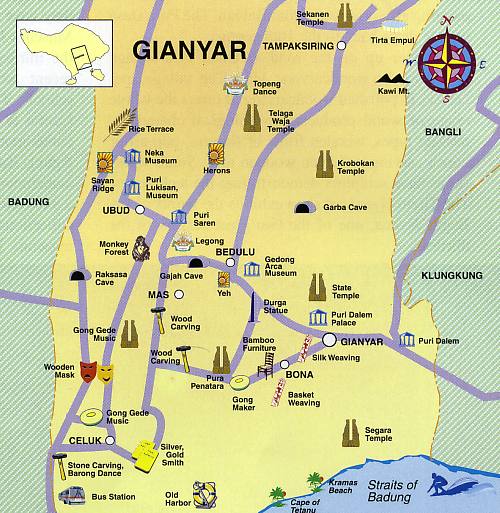|
Map Gianyar
 GIANYAR REGENCY
Capital - Gianyar Important phone numbers: Direct Enquiries -108 Gianyar Tourist Office Tlp: 93401 (Address - Jl. Ngurah Rai 21, Gianyar.) History : Batubulan Village - Stone carvings line the road, many are made on the premises however a few are also carved elsewhere. Many types of Balinese dances including trance dances are performed here for tourists. Blahbatuh Village - Gaduh Temple houses the ancient, folkloric, stone head of Kebo Iwa, a Balinese hero of the Majapahit era. Bedulu - This village houses the Museum of Archaeology, which exhibits pre-Hindu artifacts, stone carvings and old Chinese porcelain and the Samuan Tiga Temple, which stages an eleven day ceremony during the 10th full moon according to the Balinese Calendar. Bona - a village dedicated to producing bamboo products. Said to be where the Kecak dance originated. Celuk - This village specializes in gold and silver works, producing all kinds of jewellery and ornaments. Gunung Kawi - A candi complex dating from the 11th century, in which the candis have been carved directly out of the rock. The surrounding area is very picturesque. Not as dramatic as the other nearby candis and caves are Garba Cave and Candi Krobokan, two 12th century monuments, worth visiting if just to get off the beaten track. Mas Village - A village renowned for producing Bali's sacred masks. Pejeng - Home to the temple of Penataran Sasih or Temple of the Moon. It contains the famous bronze Moon Drum, said to be over 2000 years old. It is the largest, single cast, bronze drum in the world. Good examples of 13th and 14th century stone carvings can be found at the nearby Pusering Jagat and Kebo Edan temples. Sukawati - A market town selling all of Bali's souvenirs in one location. It is also a market for the local Balinese looking to buy ceremonial articles. Tegallalang - Shops abound on either side of the road. Slightly north rice terraces abound and, at nearby Petulu, see white Herons return to nest as the sun goes down. Tirta Empul - Since the 10th century Tirta Empul has been one of Bali's holiest places. Balinese come to bathe in the ancient pools as the waters are said to have curative powers. Ubud - Now the cultural and artistic centre of Bali and a blossoming tourist destination. Bali's four art museums namely, ARMA, Neka, Puri Lukisan and Rudana are all located here. The surrounding hamlets are all worth visiting. Ubud has many traditional dance and music performances and a number of workshops and courses are available. Accommodation ranging from five star luxury boutique hotels right through to guesthouses abound. Yeh Pulu - Close to the Elephant Cave are some 14th century bathing pools with interesting carvings. |
|






